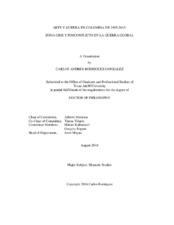| dc.description.abstract | This dissertation explores the ethical-political relationship of Colombian art production (literature, film, and installation art) from 1995 to 2015 that focused on the Colombian War. During the period of time between the 1990s and the 2000s, Colombia’s armed conflict experienced the most violent phase in its history due to the transition from a civil war confined to a closed territory to a global war. Colombia has experienced the longest armed conflict in the Western Hemisphere, and for almost eighty years the country has attempted to end it. As a result of this, Colombia has experienced partial transitions toward democracy. The current peace talks between the government and the Revolutionary Armed Forces of Colombia- People's Army (FARC-EP) (2012-2016) have finally brought the promise of the conflict’s conclusion. Nevertheless, the neo-paramilitary groups, which have integrated into the neoliberal system with military interventions in different parts of Latin America and the world, coupled with Colombia’s necrocapitalism are clear signs that this armed conflict no longer falls merely under the sovereignty of the Colombian State; this conflict belongs to the entire world.
The biggest difficulty for concluding the armed conflict is the gray zone, a political space that produces two kinds of sovereignty: one political and the other economical. At the same time, the gray zone produces both dialectizable and unconvertible violence. Art production from the past two decades has been dedicated to reflecting upon the gray zone by means of making a critique of the main concepts of political modernity, such as: confession, forgiveness, human rights, memory, militancy and insurrection. The critical review of these concepts shows that they are emptied, incomplete, full of neoliberal reformism, and thus unable to intervene in the gray zone. Making these problems of the Colombian political reality explicit also serves to make evident a set of problems that are happening in different parts of the world at this moment. The dual transition in Colombia will be the type of post-conflict transition experienced by all other contemporary wars, such as the drug wars in Mexico and Central America or the wars in Syria, Yemen, Iraq, and other parts of the Middle East. | en |


